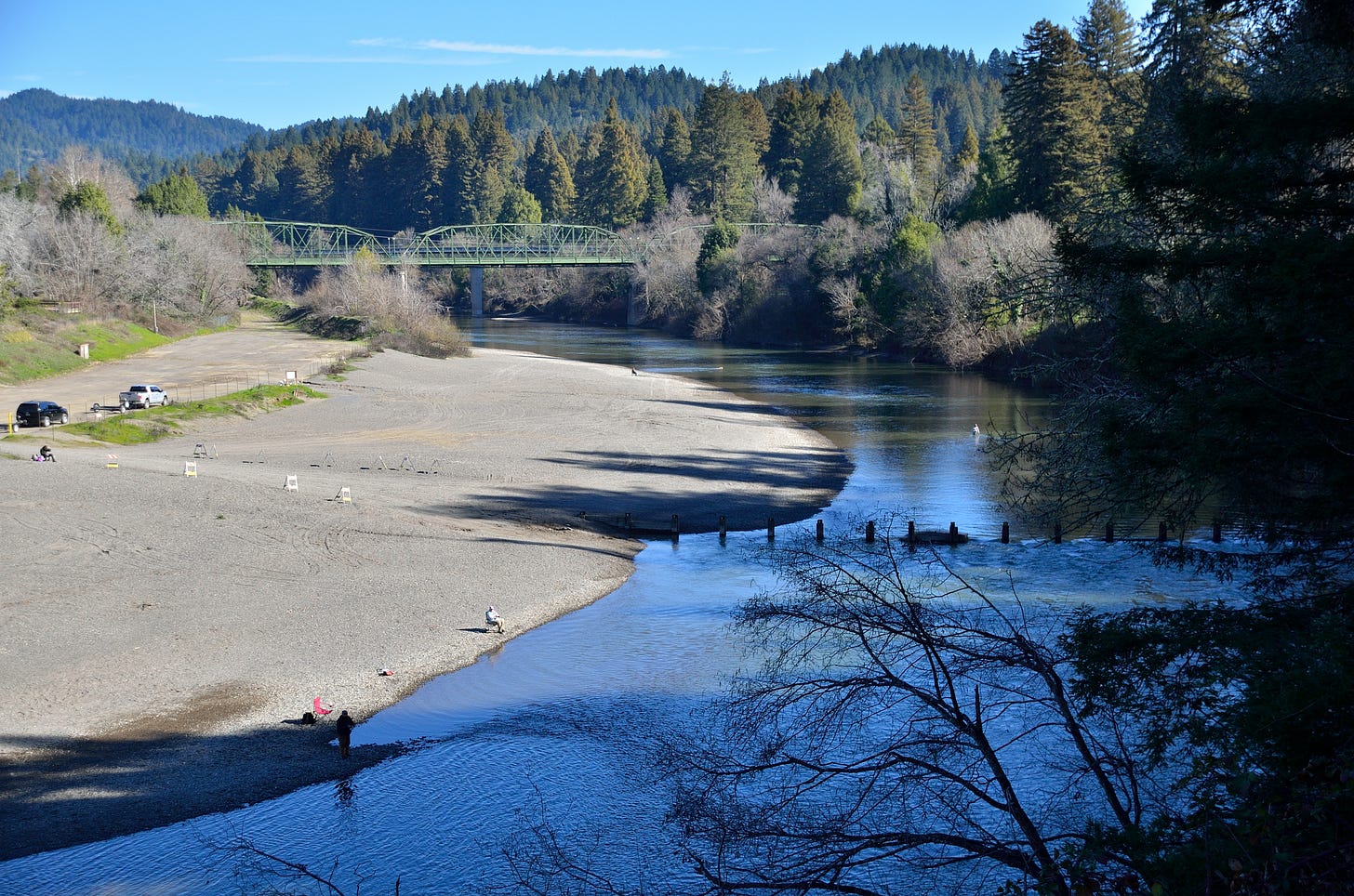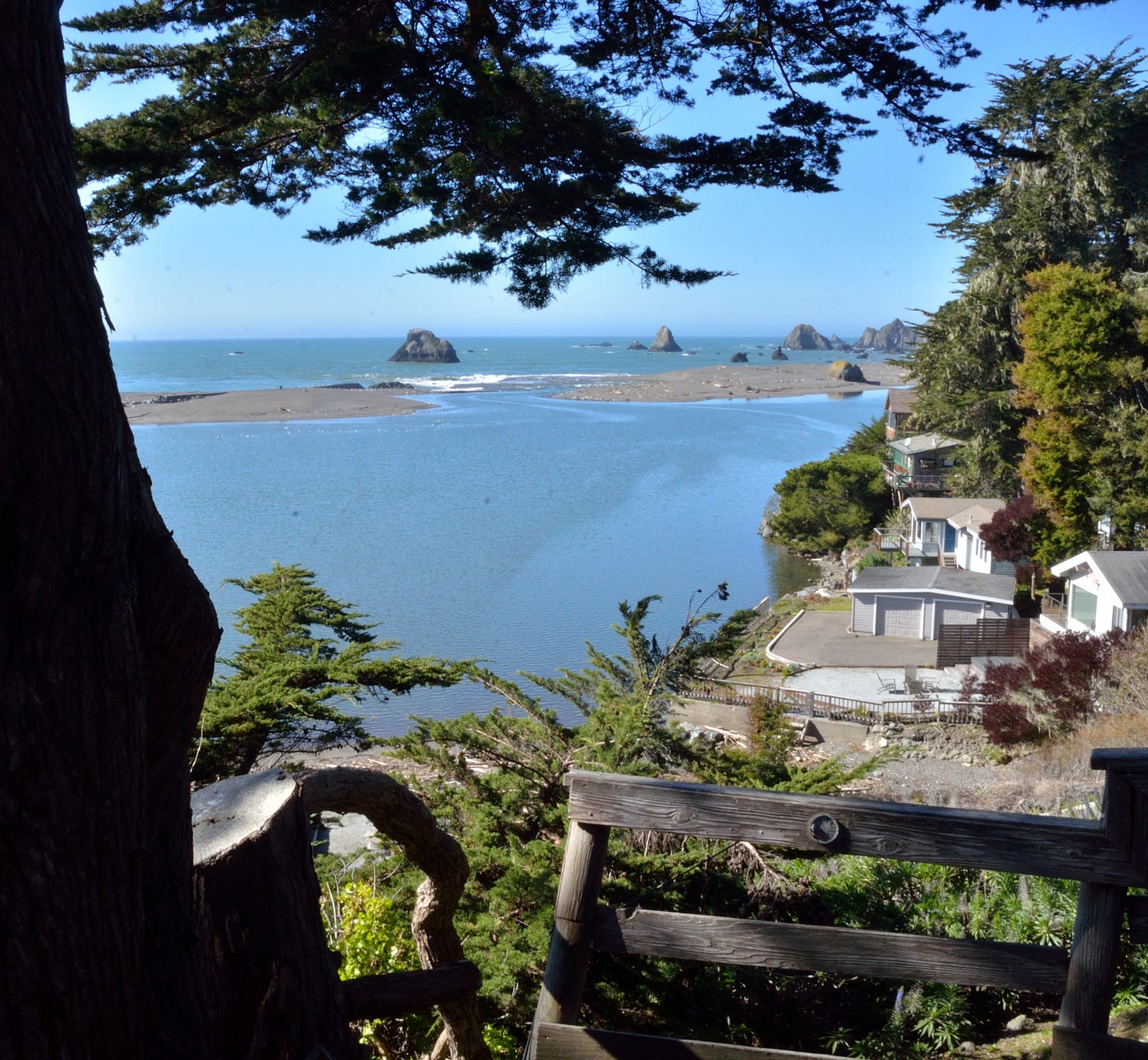The Russian River
A story about California's first world-famous fishery and the guy who became famous for helping to make it happen
Happy Tuesday everyone. When arranging the mess on my desk the other day, I found a copy of the book “I Know Bill Schaadt” by Ben Taylor. Ben stopped by to chat with me at the Author’s Booth at the Fly Fishing Show last month and had gifted me a copy of the book. When I had returned home, I placed it on my desk and then proceeded to put papers on top of it and out of sight and out of mind . . . if you know what I mean. It’s a beautiful coffee table type of book with a linen hard cover and full of stories about one of the most seminal fly fishermen of the 20th Century. Ben’s writing is beautiful and full of love for his best friend Bill. When thinking about what to write for today’s post, I thought that I would share with you an excerpt from a story I wrote a few years ago about the Russian River for Steelheader’s Journal magazine. Hope you like it.
Before I forget, just a reminder that there are only 8 days left to get 50% off on a Paid Subscription. I can really use your support. Thanks
Most of the journey to the Russian River from the Bay Area or Sacramento takes you through the tidal flats of the north bay, and the oak tree-covered hills of the coast range. About four miles north of Santa Rosa, you turn west off Hwy 101 onto River Road, and you soon find that the roadside vegetation has turned from grasslands and Oak trees to vast acres of emerald-hued vineyards of Pinot Noir and Chardonnay. Continuing westward, you notice that the ridge tops of the surrounding hills have changed from the round crowns of Oak trees to the jagged silhouette of coastal Redwoods. It’s not too long until the Redwoods are lining the road and become so dense that you temporarily lose sight of the road when your vehicle leaves the sunlit section and enters the deeply shaded curves. This is the first sign you have entered into the unique ecosystem known as California’s Lost Coast.
As you proceed, the highway begins paralleling the Russian River and continues to do so until the river dumps into the Pacific Ocean at the village of Jenner, CA. In popular fly fishing literature and cinema, “Legends of the Lost Coast”, the Lost Coast stretches from Jenner CA, where the Russian River dumps into the Pacific to the Oregon border and doesn’t veer away from the coast until you get all the way to the town of Legget where Hwy 1 merges with US 101, which is over three hours to the north. Hwy 101 then continues inland some 30 miles from the coast for about 100 miles until it gets to McKinleyville north of Eureka. That is the section that was originally deemed the Lost Coast, but once the fly fishermen discovered the anadromous fishery in the Pacific tributaries along the way, they just named everything north of Jenner the “Lost Coast”- probably because it just sounds cool. One thing that is common to all the waters north of Jenner is that they share a similar climate and are covered with forests of coastal Redwoods. The Lost Coast experiences wet winters with an average of 45 inches of rainfall per year and foggy summers who’s fog drip ads to the precipation totals. Even though the temperatures can get up into the nineties in mid-summer, the Redwoods are lush and green year-round. Also, the characteristics of the anadromous fisheries are very similar.
The Russian River originates in California’s coast range in Mendocino and Sonoma counties. It travels about a hundred miles, south through grasslands and Oak woodlands passing through the iconic wine grape growing regions of Geyserville and Healdsburg and then turns southwest into the Redwood forest region as it gets closer to the Pacific Coast. There are two Steelhead and Salmon hatcheries along the river with one being on the main stem north of Healdsburg and the other located where Dry Creek, a tributary of the Russian, flows out of Lake Sonoma. The Warm Springs Hatchery on Dry Creek alone raises about 110,000 Coho Salmon and 300,000 Steelhead each year.
Jenner
When Russian fur traders first came to the Russian River in the early 19th Century, the river supported both Coho and Chinook Salmon runs in addition to that of Steelhead. Due to the habitat degradation caused by extensive logging and agriculture, the anadromous fisheries have declined. Old timers such as long time coastal fly fisherman and Cortland (fly) Line Company Rep Joe Patterson recalled that, as late as the mid-20th Century the river still supported three Steelhead runs, winter summer and fall Though there was incredible Steelhead and Salmon runs in the Eel, Mad, Klamath, Smith & Chetco rivers some two hours to the north, they were barely known at the time to bay area fishermen as they had to only drive a couple of hours north of San Francisco to experience the finest Steelhead fishing in the country and had no reason to travel further. As the years passed, the river and its main tributary Dry Creek have been dammed blocking the Steelhead from their traditional spawning areas in the small creeks of the coast range. Though logging is no longer a factor the Coho Salmon runs dwindled close to the point of nonexistence due to habitat degradation caused primarily by the increase in the amount of acreage devoted to vineyards through which the small tributaries of the Russian River flow. Additionally illegal pot growing in the foothills has had a similar deleterious effect. I guess the production of fine wines and dope has its price. In recent years a concerted effort has been undertaken by the California Department of Fish and Wildlife, plus other stakeholders to rehabilitate habitat and increase the numbers of Coho Salmon and Steelhead returns, and it seems to be working, but it still is not the fabulous Steelhead and Coho fishery of yesteryear.
Since the water flow on California’s coastal rivers decreases to a relative trickle each summer dry season, the sand bars at the mouths of these rivers close so that Steelhead and Salmon are unable to ascend. With the first major storms of November, there is usually enough flow to blow out the sandbars and allow the fish to get upstream to their spawning beds, and they don’t waste much time doing it. Unfortunately, some don’t make it more than a hundred yards as the local Sea Lions and Harbor Seals are usually waiting for them. One day, there can be no fish in the river and overnight, they can be so numerous that it appears that one could hop along their backs to cross the river. News travels fast and once the fish arrive, it’s not long before the number of fishermen seem to be equal to the number of fish.
Being that thousands of fishermen showed up to fish the Steelhead runs of the fall and winter it was only natural that fly fishing techniques went through a developmental stage which saw the evolution of shooting head rigs. At the forefront of their development was the legendary fly fisherman, Bill Schaadt. By trade Bill was an artist and sign painter who never married but lived in a small shack in the town of Monte Rio. Tending to be a recluse, he possessed a cantankerous demeanor but down deep was quite a warm individual. He lived and breathed fly fishing for Steelhead and Salmon and his fame rose to the point that he was featured in a Sports Illustrated article “World's Best” and several other outdoor magazines and books. Much of the technology associated with the development of rods, reels and lines for fishing big water owes its existence to Bill Schaadt and others who spent their days fishing the Russian River.
Bill’s Gear
Long time friend and equally famous landscape painter and writer Russell Chatham recounted a story about Bill that illustrates the mindset that set him apart from less successful fishermen on the Russian. Russell recalls one of his first fishing trips with Bill when he was instructed to show up at Bill’s shack in Monte Rio at 3 am in the morning. On arriving, Russell made a remark about having to get started so early, and Bill’s response was that if you wanted to get the best spot you had to; first get there before anyone else and, and secondly, not be seen driving along Hwy 116 to the spot as there were times when he had been followed by other fishermen who wanted to find his secret hole. Russell and Bill piled their gear into Bill’s truck and off they went.
They cruised up Hwy 116 until they turned on a private road that wound through the Redwoods to the water. He had positioned the boat there close to his secret hole the night before so that he would have less distance to travel and wouldn’t be seen launching the boat at the public ramp about a mile away. They both hopped in and began motoring upstream in the dim light through the frog water until Bill throttled down the motor. Russell heard Bill whisper, oh shit! as before them in the pre-sunrise darkness was a pinpoint of light that could only be that of a cigarette. Bill motored his boat about fifty yards downstream of the interloper and dropped anchor. The other guy was sitting right in the sweet spot at the head of the pool . . . the sweet spot that Bill had painstakingly discovered the day before and was unaware that he had been spied upon. As the sky got lighter, Bill and Russell began casting their shooting heads into the pool, changing heads until they found ones that sank to the right depth and then hooked a few fish. Bill wasn’t happy, however, as he knew that if he were sitting where the spin fisherman was unsuccessfully flailing away, they would have caught over twice the number of fish.
After about an hour, as the rays of light began to stream through the misty Redwoods onto the water, the spin fisherman finally hooked up. The fish was all the guy could handle, and being by himself, there was no way to maneuver the boat to the shore where he could land it. All he could do was hold on as the fish dragged him and the boat downstream past Bill and Russell. Immediately, Bill took a seat and grabbed the oars and rowed the boat up to the spin fishermen’s former position and gently dropped anchor. He and Russell then began to catch and release fish after fish swinging proprietary streamer patterns that Bill had developed over the years on the Russian. About an hour went by and the spin fisherman returned, to request that he have his old spot back. Bill politely told him he would and explained that the rules of etiquette on the river required him to do so, but also warned in a no uncertain way that in the future to not even think about trying to beat him to one of his favorite spots as he would do everything in his power to always be there first.
For one of the most famous fly fishermen of his era, Schaadts' equipment was, as Russell described it “inexpensive and shabby”. He built much of his equipment himself and his homemade fiberglass rods and the guides were sloppily wound. His reels were inexpensive models with questionable drags. Regardless of their appearance, all his equipment worked flawlessly. Today you can see a display of some of his equipment on the wall of King’s Sporting Goods in Guerneville.
Steelhead are the species that one usually associates with the river and are what writers have written about over the last century.The days of spawning Steelhead stacked up so densely that one could walk upon their backs to cross the river are gone, but they still show up a couple of times a year and provide some great angling opportunity for the Russians’ fly fishermen.If you are a Steelhead fisherman, it’s worth making a trip to the Russian at least once in your life, and while standing in the cold water in the dim light of a foggy winter morning, just imagine that the silhouette of the small pram you see in the distance, is the spirit of Bill Schaadt keeping an eye on his favorite water.










